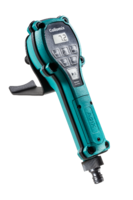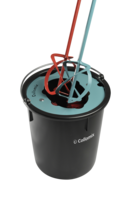
Master your mix - the 3 most important parameters for the perfect mix
Best results through precision and control
Inhaltsverzeichnis
The biggest difficulties in mixing
The 3 most important parameters for the perfect mix: #1 Time
The 3 most important parameters for the perfect mix: #2 Paddle
The 3 most important parameters for the perfect mix: #3 Speed
The biggest difficulties in mixing
Poorly mixed = expensive rework
The mixing of building materials is often underestimated and described as a “work step on the side”. However, it is a complex task that poses numerous challenges. Different materials such as concrete, mortar, plaster or construction adhesive often have different viscosities, densities and chemical compositions. If the most important mixing parameters are not taken into account, this can lead to an uneven distribution of the ingredients. If the mixing time is too short, lumps may form and the material may have a poor consistency, which impairs strength and workability. Too long or too high a speed can destroy sensitive additives or incorporate air bubbles, resulting in voids and cracks in the end product.
These defects not only lead to poorer quality, but also to increased costs due to wasted material, rework or even structural damage. Inadequately mixed building materials can, for example, lose their adhesive properties, resulting in faulty structures, or their stability can be compromised, leading to long-term safety risks. In the modern construction industry, where complex, specialized materials are processed, it is therefore crucial to ensure precise mixing processes in order to achieve optimal results and avoid long-term damage.
We therefore recommend paying attention to the 3 major parameters for a perfect mix: Time, agitator geometry and speed. With the new XQ agitator generation, you always have an eye on time and speed thanks to the digital display and can precisely control these important mixing parameters.

Parameter 1: Time

Parameter 2: Paddle

Parameter 3: Speed
The 3 most important parameters for the perfect mix: #1 Time
The right mixing time ensures the ideal mixing of the material
The mixing time is a decisive factor in ensuring the quality and consistency of building materials. Every type of building material - be it concrete, mortar, screed or construction adhesive - requires a specific processing time in order to optimally combine all components. The right duration ensures that aggregates, water, binders and chemical additives are evenly mixed and develop their desired properties. Too short a mixing time often leads to insufficient homogeneity: lumps, incompletely mixed components or uneven consistencies are common problems. This can make the material more difficult to process and, in the worst case, impair adhesion and stability.
On the other hand, too long a mixing time can also be problematic. If materials are mixed for too long, there is a risk that sensitive additives - such as chemical additives or plasticizers - will lose their functionality. In addition, the material can absorb too much air due to the excessive movement, which weakens the structure and leads to cavities or cracks in the finished component. Another risk if the mixing time is too long is that the material loses its consistency and may become too fluid, which makes processing even more difficult.
The correct mixing time ensures that the material can develop its full properties - such as strength, adhesion and workability. Precise control of the mixing time is the only way to ensure material quality. In the modern construction industry, where increasingly complex and sensitive materials are used, this is essential to avoid errors, reduce material waste and prevent long-term damage.
The 3 most important parameters for the perfect mix: #2 Paddle
The paddle does the job - the right geometry for a good result
The paddle geometry is another key factor in achieving optimum mixing results, as it influences the way in which the material is moved and mixed during the mixing process. Different geometries produce different mixing effects which, depending on the type of material, are crucial for achieving an even distribution of all components.
An agitator with a spiral or paddle-like geometry, for example, ensures that viscous or heavy materials such as concrete or viscous mortar are mixed efficiently from bottom to top. This movement ensures that materials that could settle at the bottom of the container are evenly integrated into the mixing process. Insufficient mixing of heavier or dense materials can lead to uneven distribution, which negatively affects the stability and quality of the end product.
On the other hand, agitators with a blade or propeller geometry create an effective shearing effect in more fluid materials. These shear forces are crucial for homogeneously mixing liquid or slightly viscous materials, such as certain construction chemicals or paints, and minimizing the formation of air bubbles.
The correct agitator geometry therefore determines how the material is moved - whether it is mixed from the outside in, from the bottom up or in a spiral. These different mixing effects prevent segregation, ensure homogeneous distribution and make a decisive contribution to the quality of the finished material. Without the right stirrer geometry, there is a risk of uneven results, which can have a negative impact on strength, durability and processability.
The 3 most important parameters for the perfect mix: #3 Speed
How fast is too fast?
The speed is a decisive factor for the quality of the material mix, as it directly influences how efficiently and evenly the various components of a material are mixed. Different materials - be it concrete, mortar or construction adhesive - require different speeds in order to be processed optimally. Too high a speed can destroy sensitive components, trap air and cause voids or bubbles, which affects the strength and quality of the end product. Too low a speed, on the other hand, can lead to heavier particles not being sufficiently mixed and settling to the bottom, resulting in an uneven consistency.
A constant speed is particularly important, as fluctuations in speed jeopardize the homogeneity of the material. If the speed varies during the mixing process, there is a risk that certain areas of the material will be under- or over-mixed. This leads to an uneven distribution of the components, which can have a negative effect on adhesion, strength and workability.
A constant speed ensures that the entire mixing process remains stable and that the required energy is transferred evenly to the material. This allows the material to be mixed in an even flow, which prevents the formation of lumps, segregation or structural weaknesses. Overall, a constant speed makes a decisive contribution to ensuring a high and consistent material quality, which is essential in the construction industry for durable and safe structures.




